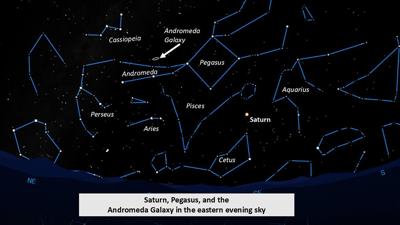September is here, a month for seasonal change. The autumnal equinox occurs on Sept. 22, marking the start of fall. The Sun will be straight overhead at the equator, and we’ll have about equal amounts of daylight and night.
Have you ever found yourself thinking, “Boy, it is sure getting darker earlier” in late August or in September? That is not your imagination. The rate of change from day to night is greatest around the equinoxes, and less around the solstices. Around the Autumnal equinox, we lose about 3 minutes of day length each day, or some 20 minutes in a week. It is noticeable! By contrast, the rate of change around the solstices is only a few seconds per day.
Saturn returns to our evening sky in September. On the 21st Saturn will be at its closest approach to us, called “opposition” as it will be opposite from the Sun in our sky. How close will it be? How about 794 million miles. That’s about 8 ½ times as far as we are from the Sun, or more than 3,000 times as far as the Moon is from us.
Saturn’s rings are hard to see this year, as the rotational axis of both Saturn and Earth are on the same plane, and we see the rings as “edge-on” or very close to it. We’ll have a better view of the rings in the next few years. We’ll have another interesting sight with Saturn though. On Sept. 3 and 19, the shadow of Saturn’s largest moon, Titan, will be visible as it passes over the planet. On the 19th, you can view the shadow transit at the Goldendale Observatory. Be sure to check the Observatory web page (www.goldendaleobservatory.com) for more information. You will need a reservation to visit before normal closing at midnight, but can arrive after midnight to see the shadow. The Observatory will be open until 1:30 a.m.
September’s full Moon will be on the 7th, with new Moon following on the 21st.
Fall constellations are in the eastern sky in September. Bright Saturn points the way to a couple of them. Look for Saturn low in the east or southeast. It will outshine any nearby stars. The dim constellation Pisces is to the left of Saturn, with Aquarius to its right. Above and slightly to the left of Saturn, look for the “great square” of Pegasus, composed of four almost equally bright stars that form a square. The “W” shape of Cassiopeia will be above and to the left of the square, and Cygnus the Swan will be above it, high in the eastern sky. If you have binoculars, look just to the left of the square, below and to the right of Cassiopeia. Scan with your binoculars, and look for an elongated, faint, fuzzy patch of light. That is another galaxy, the Andromeda galaxy, in the constellation with the same name. If you have a very dark sky, see if you can spot the galaxy with the naked eye. The Andromeda galaxy is the most distant thing we can see with the naked eye, at more than 2 million light years away.
•••
It was sad for me to see the passing of Jim Lovell, commander of Apollo 13, the 1970 Moon mission that was short-circuited due to an explosion on the spacecraft. Lovell and astronauts Jack Sweigert and Fred Haise amazingly managed to safely return to Earth, an incredible story documented in a 1995 film by the same name. Lovell flew in space four times, twice during the Gemini program and twice in Apollo. He did not land on the Moon, but circled it twice, once with Apollo 8, and also with Apollo 13. The Apollo 8 mission was by design the first humans to leave Earth orbit. The second was by necessity — the crippled Apollo 13 needed to “slingshot” around the Moon in order to gain enough speed to return to Earth quickly, before the Astronauts ran out of power and oxygen. My hat’s off to an American hero.
I remember the entire Mercury-Gemini-Apollo program, culminating in 12 people landing on the Moon between 1969-1972. By my count, 34 different astronauts went into space in those programs, and 12 walked on the Moon. Only six are still alive, including four who walked on the Moon.
Enjoy September’s night skies!
























Commented
Sorry, there are no recent results for popular commented articles.